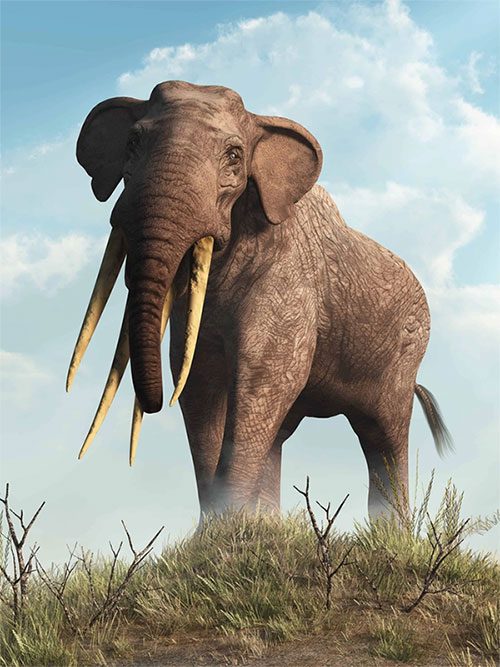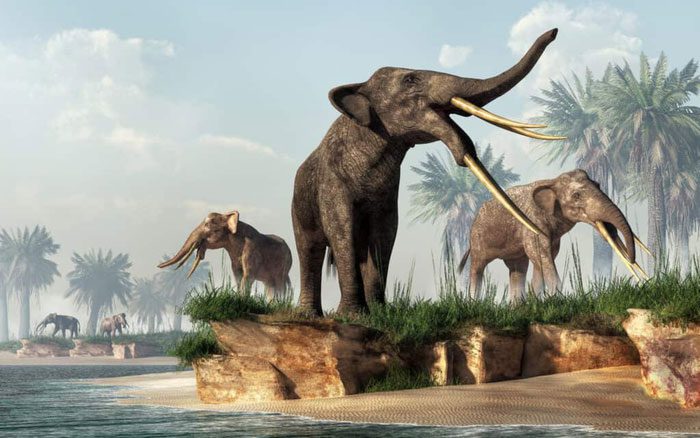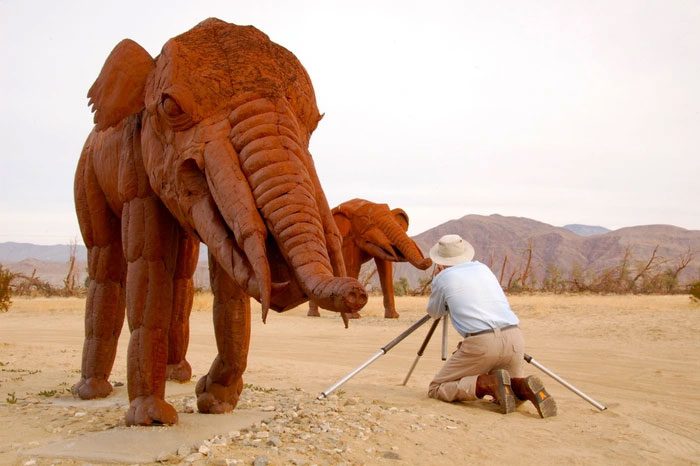Gomphotheres are an extinct species of ancient elephants that first appeared at the end of the Eocene Epoch, approximately 34 million years ago.
After the end of the Cretaceous period, when dinosaurs became extinct, prehistoric mammals began to thrive and diversify. During the Eocene Epoch, which lasted from 56 to 34 million years ago, massive elephant-like creatures began to roam through grasslands and dense forests. Although they resemble their modern descendants, these ancient elephants possessed four large tusks used for defense.

Evidence of gomphotheres dates back 34 million years to the end of the Eocene. They migrated and evolved across most of the ancient world over millions of years. Gomphotheres ultimately became extinct, with the most recent evidence dating back to about 11,700 years ago, in the current Holocene epoch.
Gomphotheres first appeared at the end of the Eocene Epoch, around 34 million years ago. They survived through the Pleistocene and early Holocene epochs. It is estimated that this species became extinct about 11,700 years ago. Although they closely resemble modern elephants, they actually belong to a different family and became extinct as the ancestors of modern elephants emerged and continued to evolve.
These giant creatures lived in grasslands, forests, and swamps. They had larger body sizes with shorter body proportions compared to modern elephants. If you lived 12,000 years ago, you would likely confuse these giant animals with contemporary elephants.

Researchers cannot pinpoint the exact causes of gomphothere extinction. They believe that changes in diet, availability of food sources, and human hunting all contributed to the decline and eventual extinction of gomphotheres. Climate change may also have been a contributing factor over time.
A notable difference between modern elephants and gomphotheres, aside from their size, is their number of tusks. Modern elephants have two tusks, which are actually elongated teeth that extend from their upper jaws. Elephants use their tusks for feeding and defense. Gomphotheres also had two upper tusks similar to modern elephants, but they also possessed two lower tusks that extended upward from their lower jaw.
Their jaws were similar to those of modern elephants but smaller relative to the size and number of their teeth. As larger teeth grew in, smaller teeth would shift towards the front of the jaw. Gomphotheres were divided into subgroups such as trilophodont and tetralophodont. Trilophodonts have three plates on their molars, while tetralophodonts have four. The structure and function of their teeth and jaws were essential for the survival of gomphotheres and provide researchers with valuable insights into their lifestyles.
Gomphotheres were once widely distributed and adapted to various landscapes. Scientists have found evidence indicating they lived on all continents except Antarctica and Australia. This species primarily inhabited Africa, Eurasia, and North America, where they foraged in vast grasslands. Many subspecies of gomphotheres have also been discovered worldwide, each exhibiting certain phenotypic variations to adapt to their environments and living conditions.
The landscapes have changed over millions of years as gomphotheres wandered the Earth. Animal species migrated, evolved, and found new territories during this time.
Similarly, gomphotheres migrated and settled in South America during the early Pleistocene, approximately 2.6 million years ago, through the Isthmus of Panama.

Gomphotheres belong to the extinct family Gomphotheriidae. Modern elephants are part of the family Elephantidae. Today, only Asian and African elephants remain, but in prehistoric times, other members like mammoths and various types of elephants existed. Both gomphotheres and modern elephants belong to the order Proboscidea, which includes animals with trunks and developed tusks.
There is not much information about other animal species that were threats to gomphotheres. Due to their large size, any other animal that wanted to hunt and kill a gomphothere would have to be larger or possess sufficiently long and sharp teeth or claws to inflict harm.
However, it can be assured that one of the main threats to this species was the habitat changes affecting their feeding habits. Since they only fed on certain types of plants, when these food sources disappeared, gomphotheres would face extinction.
Gomphotheres coexisted with early humans. Researchers have found evidence that the Clovis tribe, one of the first hunter-gatherer groups in North America, hunted and killed gomphotheres.
This tribe lived around 13,390 years ago and actively hunted, killed, and consumed gomphotheres.
|
Scientists are discovering new information about ancient mammals every day, but currently, there are 11 known genera of gomphotheres, including:
|





















































